I am constantly making updates and changes to my internet system on board Rendezvous, but I do usually settle on a stable system that I go back to when I am not testing, or when I have guests aboard. This is that system for 2020.
For the last few years, I have been using Peplink products as the core of my system, and that doesn’t change this year. In fact, there are more Peplink devices than ever, with a sprinkling of other vendors.
System Design
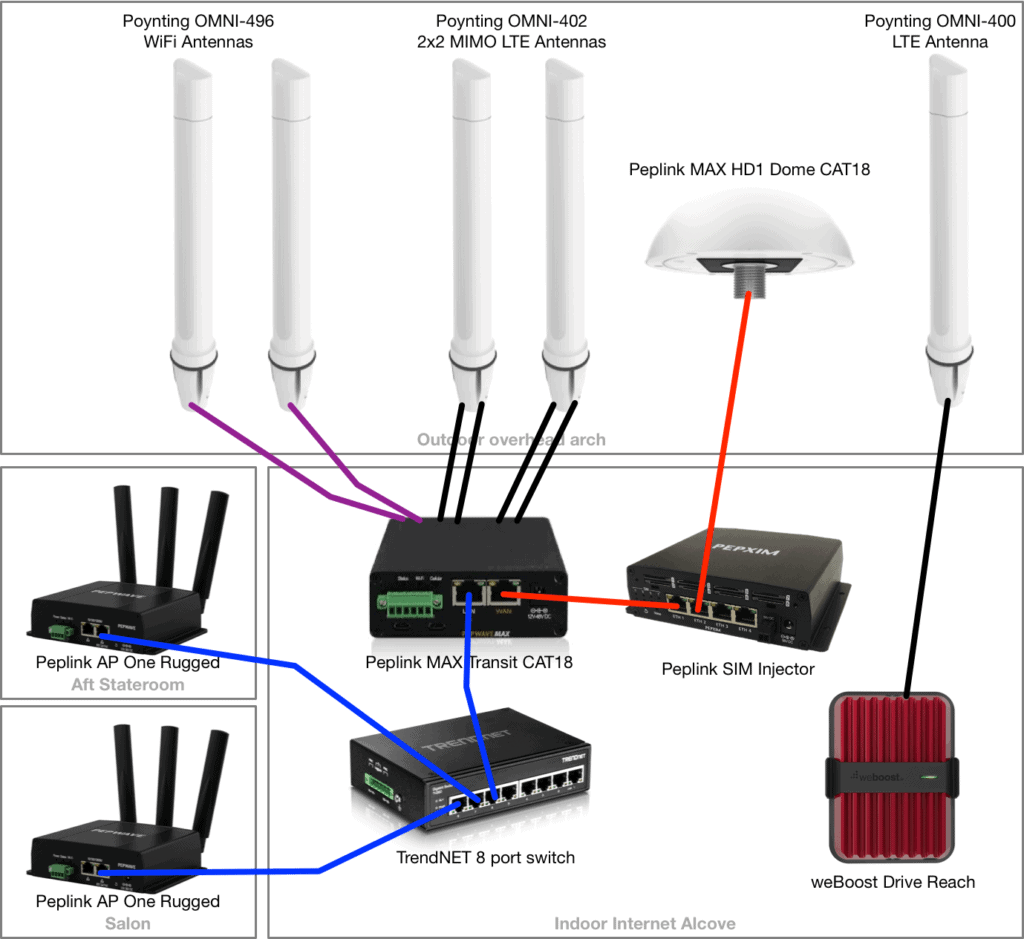
The goal of this system is to have the following:
- Continuous internet connection whether at a marina or at anchor
- 2x LTE sources that can be used simultaneously for redundancy and speed
- 2x WiFi sources at 2.4Ghz and 5Ghz to capture remote WiFi signals
- 2x internal WiFi access points for redundancy and coverage
- Central management and monitoring
- A booster for situations where signal is so low, even the higher gain antennas can’t pick it up
- Physical ethernet ports for things that need direct cabling
Equipment List
- Peplink MAX Transit CAT18
- Peplink MAX HD1 Dome CAT18
- Peplink SIM Injector
- weBoost Drive Reach booster
- 2x Peplink AP One Rugged access points
- TrendNET 8 port industrial switch
- 2x Poynting OMNI-402 LTE antennas
- 2x Poynting OMNI-496 WiFi antennas
- Poynting OMNI-400 LTE antenna
- LMR-400 Ultraflex cable for the antennas
You may notice that the MikroTik Groove is missing from this list for the first time in probably 5 years. That functionality has been moved to the Peplink MAX Transit, and I am very pleased with the performance as well as control that this has given me.
Details
Peplink MAX Transit CAT18
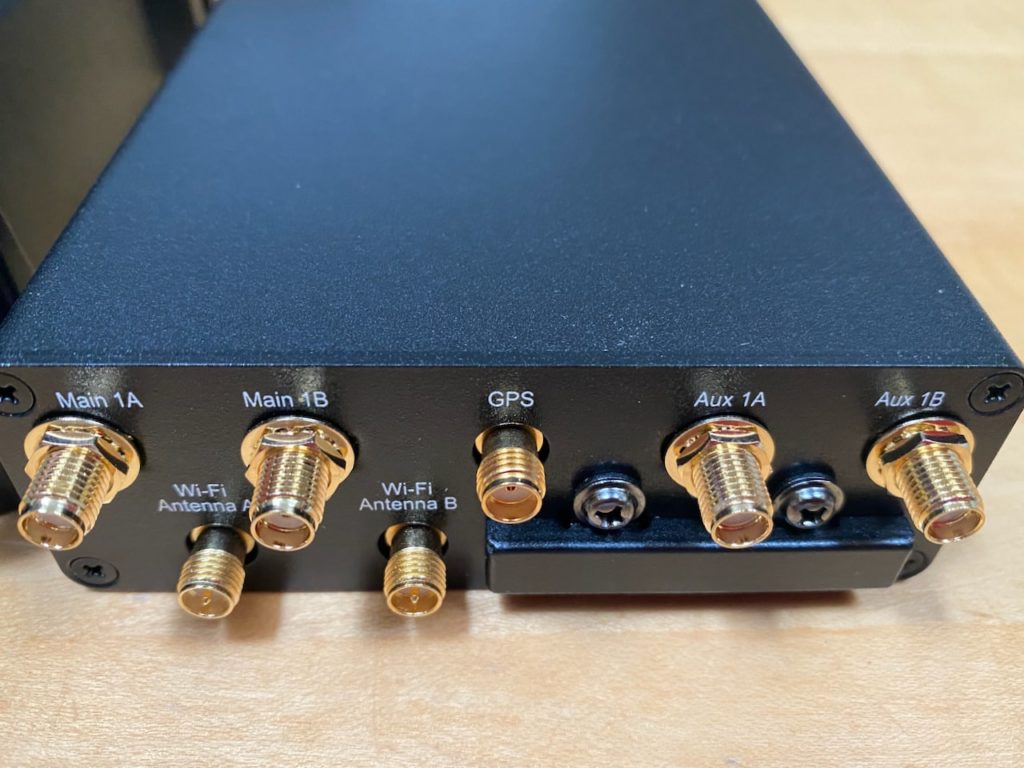
This is the core of the network. It provides the internet source either via LTE or remote WiFi, is a feature-packed router that has controls for managing bandwidth, and provides redundancy through SpeedFusion Bonding. Here are the services it provides and how:
- LTE internet source – this has 2x SIM slots currently populated with SIMs from Verizon and AT&T. It has one CAT18 radio, 4x antenna ports, leading to 2x OMNI-402 dual element 2×2 MIMO antennas on my antenna arch. I’m using LMR-400 Ultraflex cable from the MAX Transit to the antenna wires on the OMNI-402s and have kept the runs as short as possible.
- WAN / LTE internet source #2 – the WAN port on the MAX Is connected to the SIM Injector / HD1 Dome and uses this as an additional LTE internet source. Having two LTE connections allows for amazing levels of redundancy, and combined with SpeedFusion (see below) gives you tons of additional options to always stay connected.
- WiFi WAN internet source – the two WiFi connections on the MAX are connected via LMR-400 Ultraflex to two Poynting OMNI-496 WiFi antennas mounted on my antenna arch. This allows me to use these radios to search for remote WiFi networks and use them as an internet source. The OMNI-496s have performed as good as, or in the case of 5Ghz, better than the MikroTik Groove, and have a much easier to use interface, with additional useful options.
- Router features – these aren’t new from previous MAX Transit products, but have been continually getting better with the free firmware updates Peplink offers. They are critical to maintaining a reliable internet connection aboard, and include things like priority levels for the various sources, bandwidth management to make sure one device doesn’t consume the entire connection, plus some new load balancing algorithms specifically for LTE connections.
- SpeedFusion Bonding – this is also not new, but has seen some amazing improvements in the last 6 months. Essentially, this allows you to take two different internet sources, combine them into a single connection, and apply all sorts of different magic to them. You can have them both working simultaneously, use various different methods to watch performance on each, and send traffic out the best one, plus a host of other options that deserve an entire article. This has been instrumental in allowing me to work from the boat 100% of the time, no matter where I am, and participate in Zoom calls, high quality phone calls, and more.

Peplink MAX HD1 Dome CAT18 + SIM Injector
I think this is one of the most underrated products for getting LTE internet on your boat. Not only does it not require tons of antenna wires, but it can be combined with other Peplink products to make a very robust setup. You can read more about the details in the initial review I posted here.
The dome is mounted on my arch, a single ethernet cable (originally used for the MikroTik Groove) heads down to my Internet Alcove where it connects to the SIM Injector. That device has three SIM cards in it (it can hold 8!) from AT&T, T-Mobile and Verizon. It has a 12v to 48v DC buck converter powering the SIM Injector which in turn powers the dome on the roof via power over Ethernet (PoE). A cable from the SIM injector is connected to the WAN port of the MAX Transit as an LTE internet source.
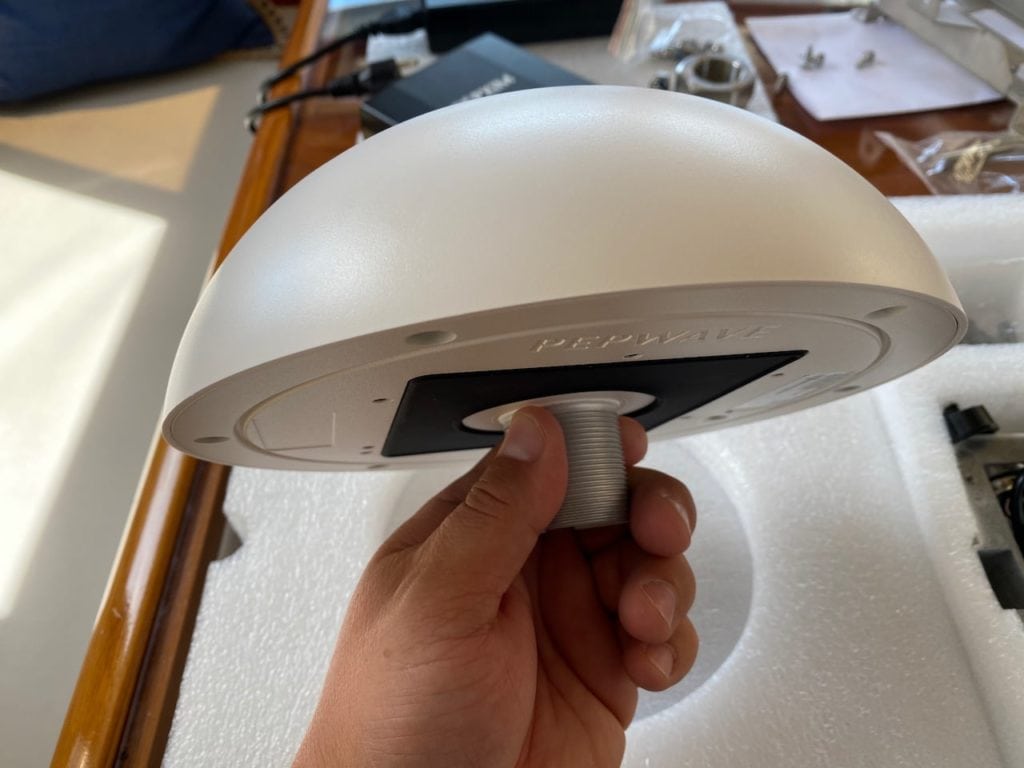
The performance I’ve seen out of the dome vs. antennas (even the MAX Transit CAT18 + Poynting OMNI-402s) is the best I’ve recorded in a long time. There are some places where the antennas do slightly better due to lower signal levels, but in almost any other situation, the dome has outperformed everything else. This of course has to do with the fact that the antennas are inside the dome, right next to the modems, with no signal loss from a cable run.
weBoost Drive Reach booster + Poynting OMNI-400 antenna
I don’t use this as much as I used to because of the quality of the signal I get with the Poynting antennas and the HD1 Dome, but I still have it setup in case I need it.
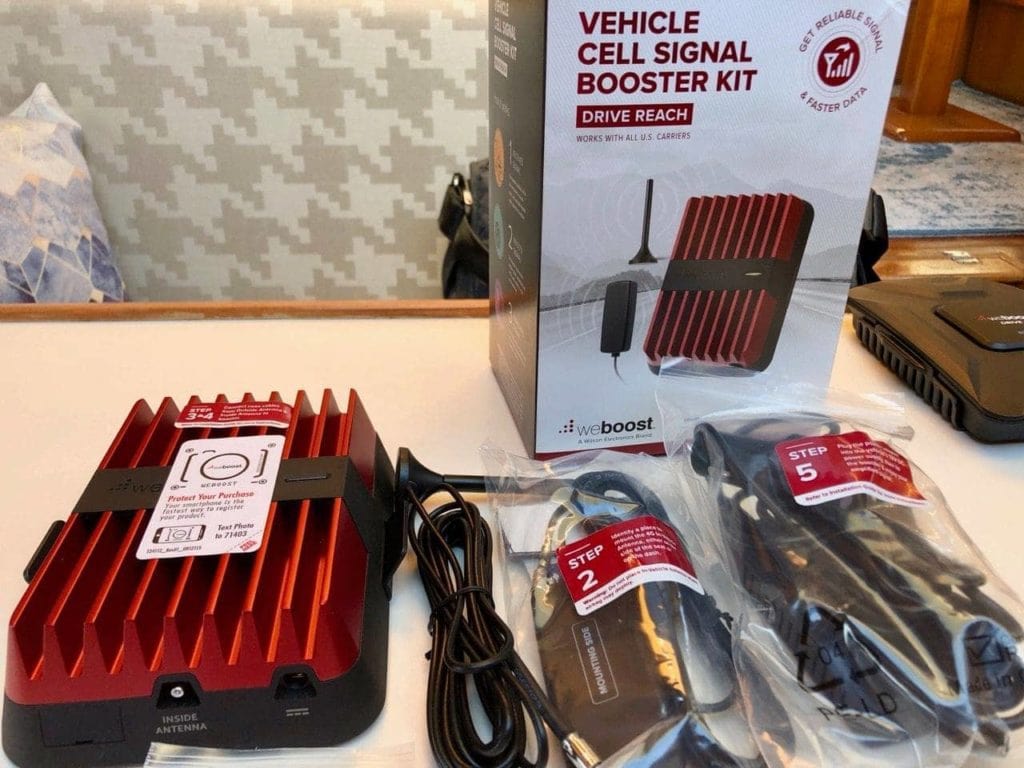
You can read more about the weBoost Drive Reach in my review on it here. It is still the best solution out there to boost 4G and most of the pseudo-5G signals, but you should really consider whether you need one all of the time.
I have mine paired with a single Poynting OMNI-400 LTE antenna. The booster itself is off almost all the time. When I do need it, I end up having to take all of the antenna cables off of the Peplink MAX Transit, put the factory antennas back on, and turn on the booster. This is not the easiest thing to do, and tends to put wear and tear on the antennas and connectors, but it is really the only way to do this short of having a secondary Peplink MAX Transit sitting idle, turned off, and waiting to be used with the booster.
Peplink AP One Rugged access points
I’ve recommended these for years for anyone needing a DC-powered WiFi access point, and have used them myself as well. This year, I have two of them in different places around the boat to ensure complete coverage, and so that if I am doing work on the MAX Transit, or testing something else, I don’t have to reconfigure my local WiFi network. This creates my local WiFi networks – one for navigation critical stuff, one for my stuff, and one for guests.
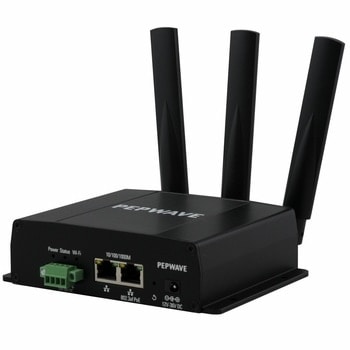
The AP One Rugged runs directly off of DC power, or can be powered by PoE. I’m using DC power myself but am testing a TrendNET PoE switch that may replace the one I have in place now. The bigger benefit of the AP One Rugged is the WiFi radio transmit power – quite a bit more powerful than any of the MAX Transit line, which means better coverage across the boat.
If you need more coverage, and have a MAX Transit or other Peplink product, I highly recommend the AP One Rugged. It can be managed by the MAX Transit, as I am doing, and complements them very well.
TrendNET 8 port industrial switch
I’ve been using these for 3-4 years and they have not failed me yet. Simple to power, low power usage, and built like a tank, they are a great switch if you need more physical ports on your network. As I mentioned above, I am evaluating a 12v DC powered PoE switch that could replace this, and end up saving me some wiring to the access points, although it has less physical ports.
Poynting OMNI-402 LTE antennas
I am using 2x of these antennas connected to the 4x LTE ports on the Peplink MAX Transit CAT18 in a specific pattern recommended by Poynting. They have performed extremely well with all providers I’ve tested them with in a ton of different locations and signal levels around the Salish Sea.
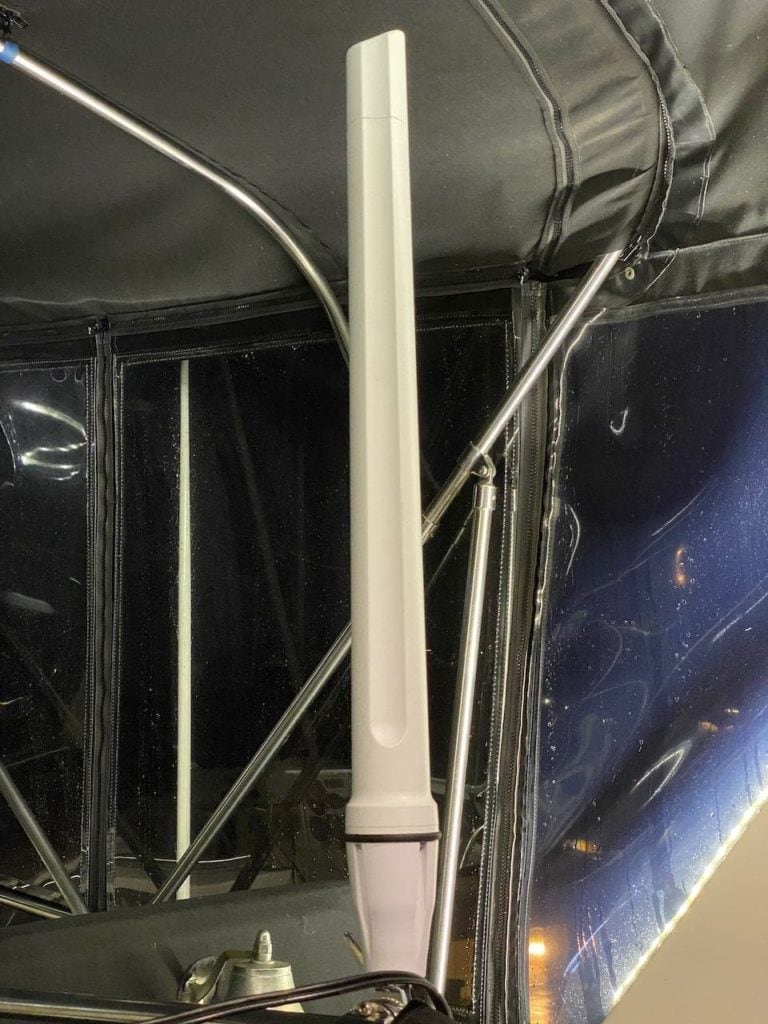
I have been a fan of the Poynting marine series antennas since I found them in 2019, and while I am sure some new antennas have a slight advantage in some area, the quality of the build of these antennas and excellent marine mounting system means they are my primary choice, and probably will be for some time. You can read my review on them here.
Poynting OMNI-496 WiFi antennas
I’ve only had these antennas for about 6 months, but they are hands down the best dual band, outdoor, marine grade WiFi antenna I have ever found. Try looking for a dual band, or even a 5Ghz, marine grade WiFi antenna, and you won’t find many options. Poynting have produced an antenna with impressive performance, similar in size and shape to the OMNI-400/402, with the same quality marine mounts.
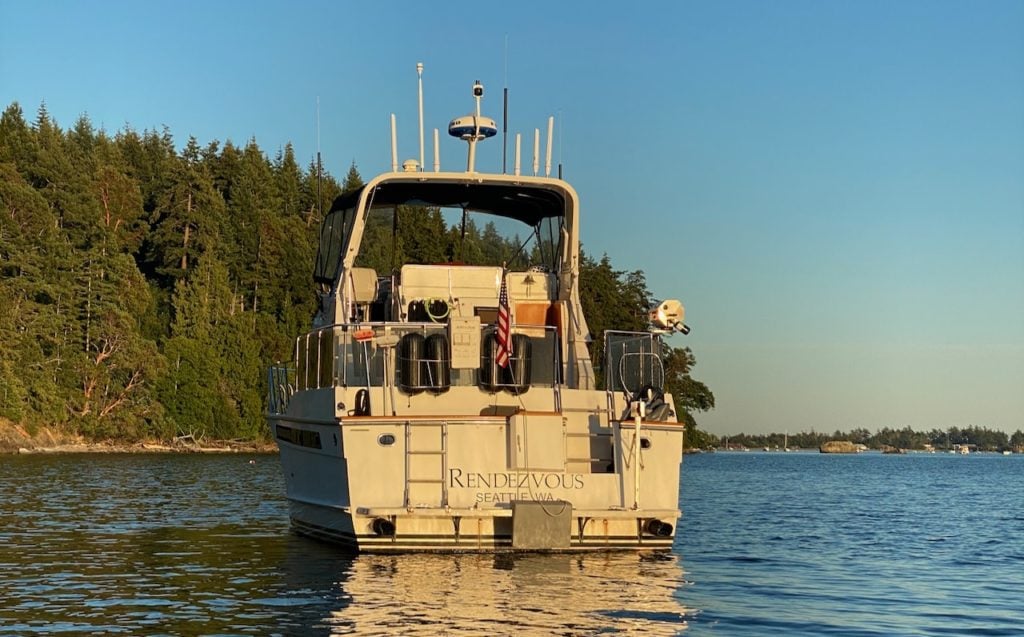
I have seen really excellent performance out of the antennas for 2.4Ghz WiFi signals, very similar to the performance I saw with the MikroTik, and that’s saying something. The MikroTik had the antenna directly attached, while the Poynting is running down some LMR-400 Ultraflex to the Peplink MAX Transit. One could assume that connecting the OMNI-496 directly to the MikroTik would make that performance better, but I prefer having the control of the Peplink software in this situation.
The real surprise was the performance on 5Ghz – I’ve never seen an antenna perform this well in marine conditions. Usually 5Ghz is almost unusable unless you are in a marina and not moving, but I have locked on to 5Ghz signals repeatedly using this antenna, and had great performance.
Benefits
CAT18 / Performance – both of my LTE sources – the MAX Transit and MAX HD1 Dome – are category 18 modems. This has helped with both overall throughput and performance, given that CAT18 modems will connect with up to 4 different bands, but it also seems to have helped in low signal areas as well, where I’ve routinely seen 2 bands instead of 1.
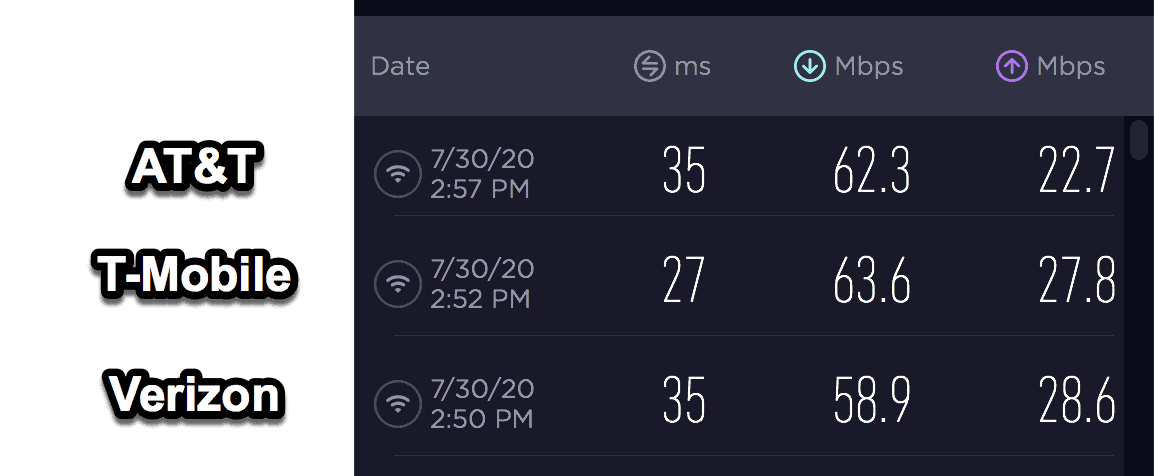
Central control from MAX Transit – This has been a big improvement, and allows for some more complex logic using various load balancing and SpeedFusion features. It has allowed for faster failovers during Zoom sessions, better quality connections, and better visibility into what is going on.
Ease of use – similar to the above, because the MAX Transit is doing almost everything, it means I can control the priority of the connections and everything else in one place. Previous systems I have had in years past had other components which required manual intervention (MikroTik comes to mind) or other challenges.
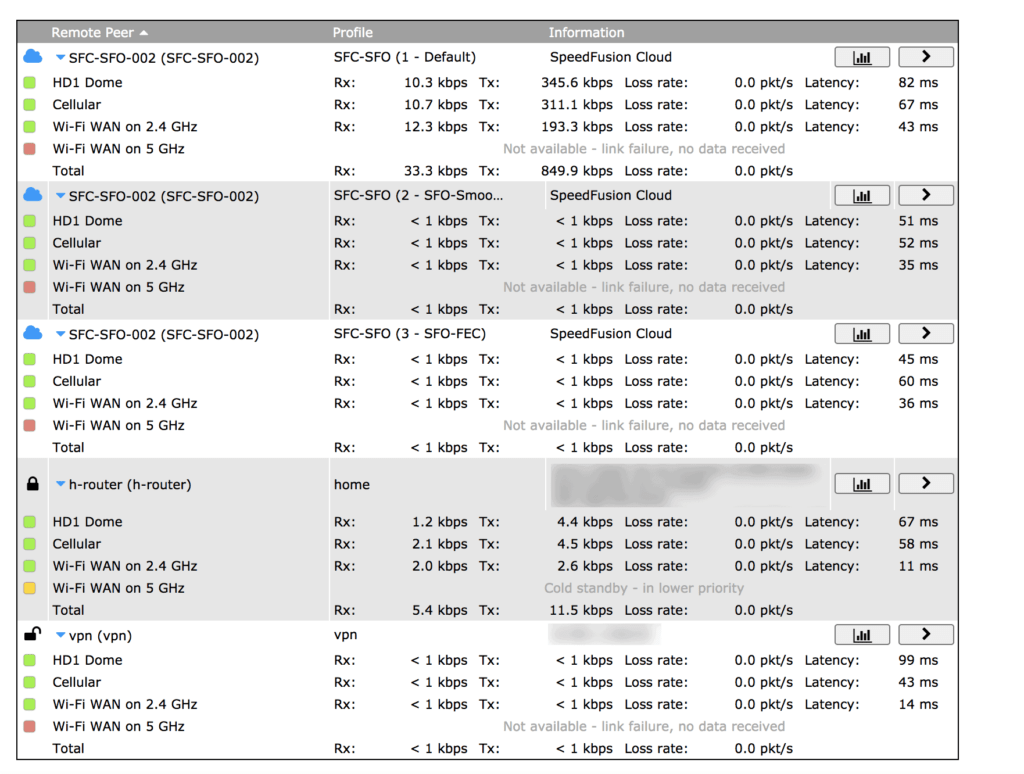
SpeedFusion / Bonding – this deserves it’s own article, but in short, it allows for redundant LTE connections and constant monitoring and control of how I am connected. It can be configured to look at individual packets, LTE performance and latency, and many other factors. You can also add rules that apply different logic depending on the device – I have WiFi calling traffic use a specific type of tunnel that is optimized for that, my laptop use a very redundant and quick failover connection, and other non-critical items use whatever is available and fast.
Powerful WiFi as WAN – the Peplink MAX Transit combined with the Poynting OMNI-496 antennas make for a powerful way to grab remote signals. It’s easier to configure than a MikroTik, doesn’t appear to have the weird connection issues that have developed over the last year with UniFi equipment, and has more options specifically for connecting as a WAN source.
Redundant access points – having dual access points via the AP One Rugged inside the boat allows for redundancy, and for maintenance on the router without disturbing local traffic. It also provides better coverage all around the boat.
Challenges
Complexity – even with most of this being Peplink equipment, there are still a lot of additional features I’m using that the average user might shy away from, and would negate some of the benefits of having the hardware if you didn’t use. There are also quite a bit more boxes involved with this setup than a single MAX Transit, but I think those are worth the complexity.
Cabling & Antenna Space – this is going to quickly become more of an issue for those of us who want multiple CAT18 modems, as they require 4x antennas each. The Dome solves this, but there are pros/cons with both approaches.
Cost – a sidebar
The push to work remotely in the last 6 months has really shown both the positive and negative sides of internet solutions on boats. In particular, it has shown some of the challenges with using the different solutions available, and that simple connectivity isn’t the norm anymore – high availability and bandwidth have become even more important with Zoom calls and critical traffic.
There are many people who balk at spending a few hundred dollars for internet aboard. This isn’t a home network connection – it’s a lot more complex on a boat, and that means more cost. If you want something redundant with failover (do you have that at home? I bet you don’t…) that uses multiple LTE connections, that’s going to cost more. If you’re looking for a budget conscious solution, that’s OK too, but you’re not going to get the performance of this system, nor the features or redundancy.
I can’t tell you how many times someone has engaged with me and been frustrated at how expensive some of this equipment is, yet in the next sentence, talk about how they spent 2 weeks in a boat yard ($) replacing all of their marine electronics ($$$) and other work that was done. If being connected reliably is even 50% as important to you as having a reliable electrical system, engines, etc. then why aren’t you OK with spending money to make it that way?
There are tons of ways to get internet aboard, and many are cheaper and simpler than this solution. Those include things like hotspots, tethering to your phone, or any number of MikroTik, Amarok, and other manufacturers routers that will do just fine. However, they do not have the features, redundancy, or power of this system.
This market is also not anywhere near as big as the home / “prosumer” internet world. There are more vendors than ever before, but it is still a drop in the bucket compared to companies like Netgear, UniFi, Google, Eero, TP-Link, who sell home equipment. Few of those vendors offer redundant internet connections, and even less offer an LTE connection of any kind – most of them are just as a backup.
This configuration provides highly redundant, always available connectivity from just about anywhere you could think of in a coastal cruising situation. I require this for my job, and I am willing to pay for it. The overall cost of this system is a bit beyond $5000, not including my labor to install it. Or, the cost of a new chart plotter and sounder, a haul out for 2 weeks with bottom paint and some other small work, 5x 100 amp hour LiFePO4 batteries (not installed)…
Wrap up
I’m always constantly refining my setup, so even a few weeks after I publish this, there will likely be minor changes to help optimize it for whatever I’ve found. I also have a ton of other equipment and solutions that I have been testing in 2020, and those slide in and out of this setup as needed depending on their capabilities.
However, just like with my NMEA 2000 / boat network, I have a core set of equipment that I always rely on when I need something reliable, and when I am not testing, and that is what you see above.
I’m very pleased with the performance and reliability of this system, and the control I have over everything. Compared to last year, I have more LTE connections with better modems, much better antennas, and a better WiFi as WAN solution, combined with more powerful internal access points. What’s not to love?
Archived Comments
These are read only comments from the old system. Scroll down to participate in SeaBits Discussions, our new interactive forum attached to each article.
Captain Jack R
August 23, 2020 at 8:07 pm
Starlink is going to be a game change when it is fully operational. I talked to a gentleman who works in Redmond, Wa facity about the theoretical capability of Starlink. He told me that with an antenna about the size of large pizza box that you can mount on the top of your roof at home, you’ll be able to get very fast broadband internet that it would compete with local internet providers in both price, speeds, and location (rural areas). I asked him would it work on a boat. He wasn’t sure but there was another company that had built a flat antenna that fits on top of an SUV that was able to handle off-road use while still maintaining a good connection. No more gimbaled dishes.
I couldn’t get any more information as he didn’t have the liberty to say. I could tell he wanted to say more but I said don’t fret, we will all learn more when the system is all turned on. I did ask about if online gaming would work on Starlink. He said yes, but don’t expect to outperform fiber to the home. It can outperform current cable internternet providers.
What I personally predict that residential internet providers will have to lower their pricing to compete. Or offer fiber to your house before breaking it up to cable. They will also would have to offer near zero ping to the backbone.
I also predict that current off-shore sattlite service provider become obsolete or at the very least, discount their service fees.
Massimo Sirolla
August 24, 2020 at 10:26 am
Hi Steve,
After your comments on the Teltonika RUTX 11, which seems to be a great all-in-one router, I have noticed that the company has partnered with QU Wireless to offer an all-in-one system which includes all the antennas, and the router, all in one block to install outside. See here: https://quwireless.com/product/QuRouter-X11S
This looks like a brilliant system where you want a budget solution and/or do not have much space on the boat for antennas, etc. The router is inside the external antenna element, so the only wire you need is the power, or a POE cable if you need a LAN cable inside the boat.
The declared gain performance of those antennas seem good, and there is the advantage that there is no loss between the antennas and the router, as the RUTX11 is where the antennas are.
What do you think? It would be great if you could review this setup, as if it’s any good, it’s a brilliant low-cost low-space system.
Adam
August 25, 2020 at 4:54 am
Hi Steve,
Very helpful post as always. When you mention the antennas are arranged for cat-18 as recommended by ponyting, what did you mean? Thanks!
Mihaly
September 2, 2020 at 1:06 am
Great stuff Steve. I Learned a few new tricks!
In Canada, I’m finding hard to source the Poynting antennas, mainly the 402s. Where did you buy your antennas from? The Poynting website is not helpful. I’m also on a tight budget, but making minor tweaks following you lead when soft cash comes to hand.
Maciek Sarnowicz
September 26, 2020 at 7:24 pm
Hello Steve,
Thank you for a great article. A few questions:
1) Do you have an opinion about Poynting 7-in-1 antenna that seems to be well setup for Peplink Max Transit, but maybe more for RV market than Boating. Still, I would like to simplify the antenna installation.
2) Is there a use for SpeedFusion if there is only one LTE tuner in the setup? I think you are using it with tuners from MaxTransit + HD1 Dome.
3) Reading Peplink site, it seems that SpeedFusion is only available with some kind of subscription. Do you have an experience with that?
Matthew
September 29, 2020 at 9:54 pm
Hi,
Could you leave the external antennas connected when using the weBoost Drive Reach kit? Would the boosted signal be picked up by the Peplinks LTE external antennas in the same way swapping to small factory antennas would?
David de Regt
October 25, 2020 at 5:41 pm
Hey! I was just linked to this thread from an MBYC post, and now have to follow your blog. 🙂
We’re currently doing the great loop on the east coast (well, this year, the great up and down the east coast, anyway, maybe next year Canada will let the dirty Americans in), and working full time, so have similar problems as you do. My current solution is based around a single WirEng GigaMIMO (2×2 MIMO huge omni antenna), which we use basically 100% of the time. I find our Wave Wifi booster to be essentially useless. I’m using a Cradlepoint IBR1700 router that’s … okay, but if I were to do it over again I’d definitely go with the Peplink. We have our own similar blog post, though our setup isn’t as complex as yours, and I’m not as happy with it. 🙂
I’m curious if you ever tried out the WirEng antennae. When I was first accumulating a setup for working from the boat, I was looking heavily at the Poynting stuff, because it had pretty large gain numbers for the size, but ended up taking a risk and going with the WirEng setup, just to ideally make sure we really had the best gain possible. So far it’s worked out pretty well — only one spot on the trip have we had zero internet for a few minutes, and it’s a known completely dead spot on the Alligator River. At the end of the day, I’d take a tiny drop in boost for a true 4×4 MIMO setup to get the increased throughput the rest of the time.
Going back to your setup, it appears that you basically have 3 different echelons of connectivity:
1. Great local connectivity — the dome setup. Least gain, but no loss because the modem is inches from the antennae, so great SNR, and maximum throughput, if it works.
2. Moderate connectivity — the two Poynting 2×2 LTE antennae for 4×4 service. Pretty good gain, but lossy because of the long cables down to the modem. Pretty good throughput, I assume, assuming you still have connectivity.
3. Bad connectivity — the booster on one of the LTE antennae that you manually swap in. Noisy as heck, so low throughput, but will eke out what it can in the worst connectivity situations.
Is that accurate? It sounds like, the majority of the time, the dome setup is what you’re on, even out in remote sections of the Salish Sea? I just moved our solar setup from our hardtop to our bimini, which frees up a bunch of space for more antennae to go up there, so I’m tempted to try out some of the equipment you’ve found to be effective here.
Finally, can you share what your sources of SIM cards are? We’re currently on 3 SIMs:
1. Verizon prepaid unlimited ipad plan — 55$/mo, not available anymore. It’s super deprioritized, so on any congested towers/rural areas where the tower has limited bandwidth, we get the shaft during prime time. But it is truly unlimited, and often times can get crazy bandwidth.
2. AT&T “unlimited” through NoLimitData — 80$/mo, 500GB/mo max before getting shut off. It’s somewhat deprioritized, but at least in the northeast, it’s what were on 90% of the time.
3. Google Fi — I’m sure you know how this works. Backup that gets us Tmo/Sprint/etc. in case of emergency connectivity needs. Low limits.
Scott
October 25, 2020 at 11:42 pm
Steve, could I trouble you sir for the model of PoE switch you reference that runs on 12VDC? The lowest DC voltage I’ve found on TrendNet is 24V, and I’ve been struggling to find a 12V supply PoE (preferably L2/managed) unicorn switch. Cheers
Peter Blom
October 26, 2020 at 7:20 pm
Hi again Steve,
we interacted a few years back (https://seabits.com/best-lte-antenna-booster-boat/#comment-5119170980) regarding placement of antennas on a sailing catamaran. I was just about to install my MikroTik Groove antenna up in the mast when I happened across this updated network setup article.
Would you recommend I ditch the MikroTik Groove antenna, and instead speed order two Poynting OMNI-496 antennas? Or is the difference not big enough to warrant a rethink in the moments before installation?
- Steve Mitchell
October 26, 2020 at 7:47 pm
Hi Peter,
Good to hear from you again.
If you’re planning on putting the MikroTik/Antenna at the very top of the mast, then I would definitely still use the MikroTik. That way you only have to run CAT5 down the mast, which has no loss essentially. If you decided to put two OMNI-496’s way up there, you’d have to run antenna cabling up there too, and the loss would be significant.
Matthew
October 30, 2020 at 10:01 pm
Hi,
Can you explain the Omni 402 cross connected wiring configuration please? In terms of cabling to main and AUX ports – are both coax from 1x 402 antenna going to the same MAIN/AUX pair or are you sharing 1 x 402 across MAIN and 1 x 402 across AUX?
I am looking at a yacht setup with Teltonika RUTX11 or RUTX12, my concern is the number of antennas required. The Omni400 is available in my location and I was going to use 2 of them as external MAIN and AUX on the RUTX11, which has dual sim with fallback, single modem. However also found the RUTX12 that has 2 x LTE modem inside. However doubles the number of antennas required.
I am looking for range when underway but good stable connection for videoconferencing at anchor. I am unsure if using the MIMO/DIversity/AUX as external is really required – I have used just the provided inside antenna which seems to work in high strength areas on other setups.
Thanks in advance
M
David de Regt
November 26, 2020 at 5:45 am
So I finally took the plunge and just finished a couple days of fishing wires and changing a pile of random stuff out, and now I’m running an el-cheapo variation (~2300$ total) of your setup, which I can add a dome to down the line if I find myself still wanting more:
* Max Transit Duo LTEAPro
* AP One Rugged
* 2x OMNI-402
* 2x OMNI-496
Ran power up to the hardtop, and just mounted the MAX Transit up there, with all of the antennas connecting to it on shortish leads, and a CAT6 cable down to the salon to the AP One. After a few days of verifying this works well, I’ll dismantle the old Cradlepoint setup completely, run the cables back up to the hardtop, and do some back-to-backs over the next month with the 402s vs the GigaMIMO, to see if it actually does have more gain.
Do you have an update on the 12V POE switch you’re playing with? I need to pick up a 12V switch since the AP One doesn’t have an integrated 4 port solution, and jumping into POE might be nice for future adds.
I’m still getting used to the paradigms in the Peplink software, but, aside from the super-wonky (IMO, anyway, though I’m likely missing something) AP controller setup, it’s been pretty damn easy. I need to start doing smart routing rules for voice traffic going to speedfusion cloud automatically. Still struggling a bit with getting the speedfusion cloud stuff intelligently set up, with a separate SSID and such, and having it still broadcast out of the Transit MAX instead of the AP One, but I’ll get it all figured out. Might be useful if you put out an article on all your peplink tips and tricks. 😀
Peter Molettiere
December 20, 2020 at 9:18 pm
Hey Steve,
I’ve decided to follow your lead, with a Max Transit and two Poynting Omni 402s. I’m looking at installing, and given the geometry I have to deal with on my boat, I have to extend at least one of the antenna runs to install this. I’ll also have to cut the preinstalled SMA connectors off the antennae in order to run the cable through the pushpit.
Would you recommend placing the Max Transit equidistant to the two 402s, or placing is as close as possible to one, and only extending the other? I get “place it as close as possible,” unfortunately, there is no place where both preinstalled antenna pigtails reach.
I’m also interested in your thoughts or recommendations on field installable SMA connectors.
Thanks!
David de Regt
January 3, 2021 at 6:49 am
So it looks like we’re closing on buying a new boat next week, and now to figure out a full internet setup for it. The boat has a full hardtop as its highest point, but I need to use the folding mast to be able to clear all the bridges in FL (and further north on the loop as well), so I need everything to be collapsable. Hence, I’m probably going to end up getting a custom SeaView mast, and thinking about how to set this all up. Have you gotten any advice from Poynting on how far to separate the 402s (or the 496s for that matter)? I read some anecdotal stuff about 2-3 wavelengths minimum separation. For 700mhz that’s ~1-1.5m, and for 2.4/5ghz it’s only a fraction of that. If 1.5m separation is really good enough, then the off the shelf arms are good enough separation and I just need to do two levels of them (so I can put three 402s across two levels, and two 496s on one of the levels inboard of the 402s). Just trying to get some idea if you have suggestions on what’s really effective or if I need to get something wider and more custom.
- Steve Mitchell
January 4, 2021 at 2:32 am
Congratulations on the new boat!
Poynting recommends at least 1M separation for almost all of their antennas. The further the better of course. - David de Regt
January 4, 2021 at 11:12 am
Thanks! I also can’t find anything on vertical separation. From my basic understanding, any non-overlap is good enough since it should be nearly perfectly radial. Does that match your experience/knowledge?
I think I’m going to try to end up with a seaview mast having two of their V-shaped antenna-holders that each have two 1″ mounts per side. I can stick the LTE antennas at the tips to get 1.5M horizontal separation and then a few inches of vertical separation, and the wifi antennas one on each inner holder to get less horizontal but full vertical separation.
(This annoyance is all because of all the bridges on the ICW, so we’ll have to lower it all the time, so I want just one lowering device that clears everything rather than individually lowering 5 antennas AND a radar mast.) - Steve Mitchell
January 5, 2021 at 2:13 am
Vertical separation is not as important as horizontal. The Seaview mount sounds like a good idea. I know they also make electric ones that can be lowered with a button if it’s something you have to do frequently!
forpar
January 23, 2021 at 11:19 am
Steve, have you tried the 7-1 antennas from poynting or parsec? I am curious how they compare to the 402?
- Steve Mitchell
January 23, 2021 at 12:49 pm
Depends on which ones you’re talking about. In general, the smaller puck-style 7-in-1 antennas are pretty terrible on a boat. I’ve tried the MobileMark, a Parsec, and one Poynting, and the MobileMark was the best, but it still paled in comparison to a normal sized antenna.
I have been very impressed with one from Peplink I’ve been testing – the Puma series. I will be publishing some notes on that one soon.
Kevin d'Eon
September 28, 2021 at 12:19 pm
I love reading all your comments and setups.. One question is. What is the best setup for long range or very bad signal areas? I have all the room in the world on my boat..
- Steve Mitchell
September 30, 2021 at 3:36 pm
Hi Kevin,
I answered you in email too, but in general, the best solutions I see involve high quality antennas with good, short cabling to 2×2 or 4×4 MIMO CAT12 or CAT18 modems. Boosters can help in some situations, but good antennas tend to work in more situations, more reliably.

